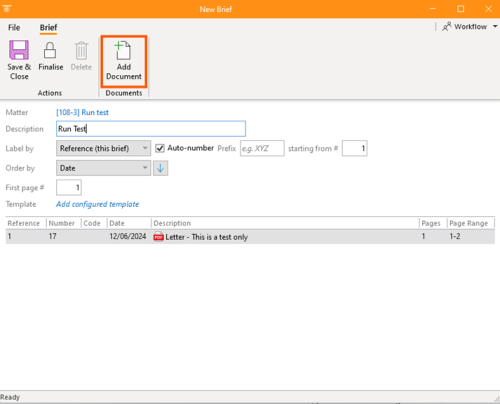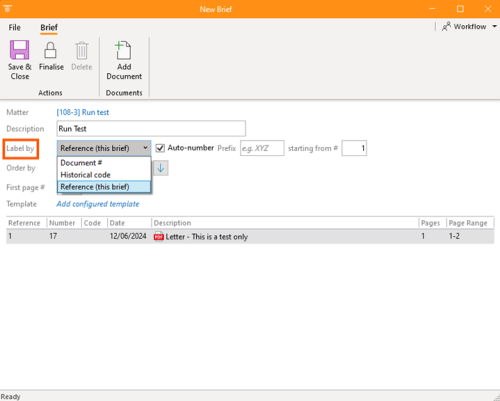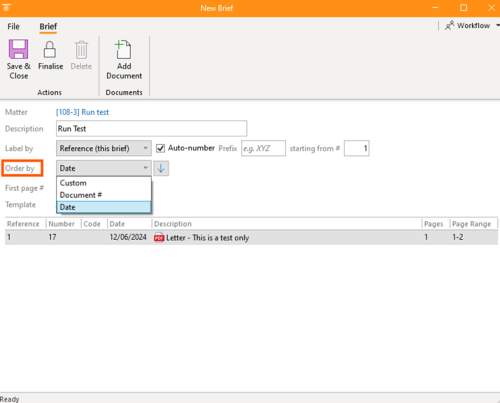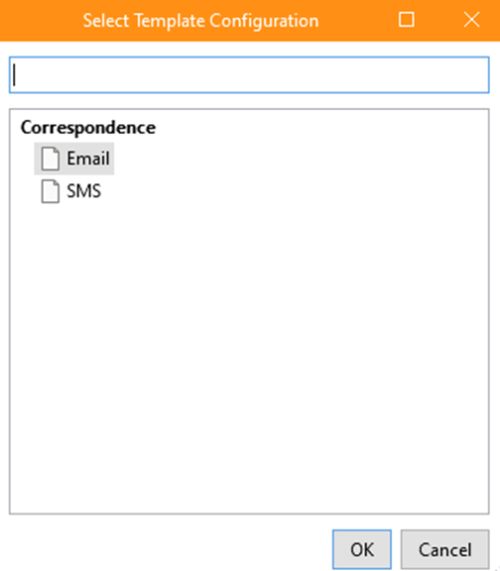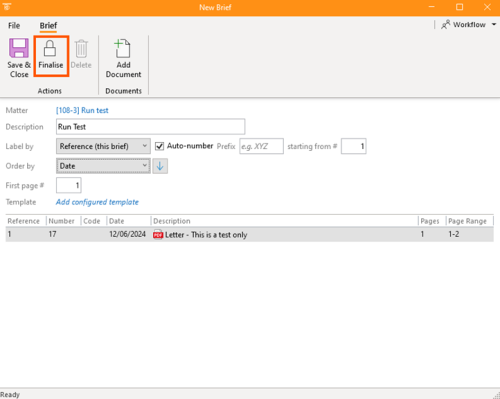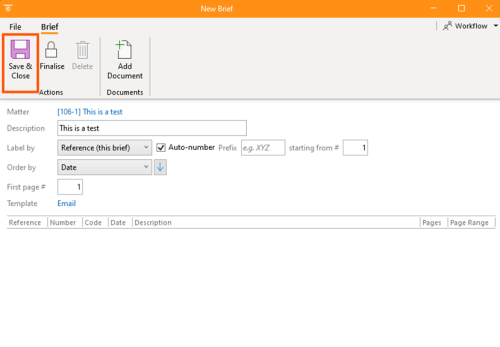How-To:Brief: Difference between revisions
No edit summary |
No edit summary |
||
| Line 10: | Line 10: | ||
* Creating indexes or tables of contents for legal documents. | * Creating indexes or tables of contents for legal documents. | ||
1. Access the Briefs Feature | |||
1.Open the app | * Open the app. | ||
[[File:Step 1 - Brief Document.png|none|thumb|500x500px]] | * Navigate to the '''Documents''' tab of the matter you are working on. | ||
* Ensure all necessary documents are uploaded to the system. | |||
[[File:Step 1 - Brief Document.png|none|thumb|500x500px]]2. Create a New Brief: | |||
* Click '''Documents''' dropdown. | |||
* Click on '''Create Brief'''. | |||
[[File:Step 1.2 - Brief Document.png|none|thumb|500x500px]] | [[File:Step 1.2 - Brief Document.png|none|thumb|500x500px]] | ||
3. Add Documents to the Brief: | |||
* Select the documents you want to include in the brief. You can do this by: | |||
** Dragging and dropping the documents. | |||
** Using the copy-paste method. | |||
** Adding documents through a search function. | |||
3. | * Identify all the documents you need for the brief. | ||
[[File:Step 3 - Brief Document1.png|none|thumb|500x500px]] | |||
4. Configure Brief Settings | |||
* '''Matter Selection''': Confirm that the brief is associated with the correct matter. | |||
* '''Document Labelling''': Choose how to label the documents: | |||
** '''Document Number''': An internal reference number unique to the system. | |||
** '''Historical Code''': A reference code from a legacy system or another source. | |||
** '''Brief-Specific Reference''': A unique reference for the brief only. '''Auto-Numbering''': Automatically assign sequential numbers to documents with optional prefixes. | |||
[[File:Step 3.2 - Labelling.png|none|thumb|500x500px]] | |||
5. Arrange Documents: | |||
* '''Sort Order''': Select how the documents should be ordered: | |||
** Custom order (manually drag and rearrange documents). | |||
** By document number. | |||
** By date. | |||
* '''First Page Number''': Specify the starting page number if the brief will be inserted into an existing document. | |||
* '''Template Configuration''': Choose whether '''Email''' or '''SMS'''. | |||
[[File:Step 3.3 - Order.png|none|thumb|500x500px|[[File:Step 3.1 - Brief Document.png|none|thumb|571x571px]]]] | |||
6. Finalising the Brief: | |||
# '''Generate the Brief''': Once all settings are configured, finalise the brief to generate the document. | # '''Generate the Brief''': Once all settings are configured, finalise the brief to generate the document. | ||
# '''Review and Edit''': Open the generated document to review. You can add additional content and make necessary changes. | # '''Review and Edit''': Open the generated document to review. You can add additional content and make necessary changes. | ||
# '''Save and Draft States''': Briefs can exist in draft or final states. Once finalised, you cannot make changes to the documents in the brief. However, you can redraft if needed. | # '''Save and Draft States''': Briefs can exist in draft or final states. Once finalised, you cannot make changes to the documents in the brief. However, you can redraft if needed. | ||
[[File:Finalising the Brief.png|none|thumb|500x500px]] | |||
6. Then click '''Save & Close'''. | |||
[[File:Step 4 - Brief Document.png|none|thumb|500x500px]] | |||
=== Advanced Features === | === Advanced Features === | ||
| Line 75: | Line 57: | ||
* '''Hierarchical Arrangement''': Arrange documents hierarchically, useful for grouping emails with their attachments. | * '''Hierarchical Arrangement''': Arrange documents hierarchically, useful for grouping emails with their attachments. | ||
* '''Templates''': Use different brief templates for various purposes to streamline the document creation process. | * '''Templates''': Use different brief templates for various purposes to streamline the document creation process. | ||
Document briefs are powerful tools for organising and referencing documents in legal matters. By following the steps outlined above, you can create, manage, and finalise briefs efficiently, ensuring all your documents are well-organised and easily accessible. | Document briefs are powerful tools for organising and referencing documents in legal matters. By following the steps outlined above, you can create, manage, and finalise briefs efficiently, ensuring all your documents are well-organised and easily accessible. | ||
[[Category:How-To]] | [[Category:How-To]] | ||
Revision as of 08:27, 13 August 2024
Document briefs are essential tools for organizing and referencing documents in legal contexts, such as affidavits or tables of contents. In this guide, we will explain what document briefs are, how they work, and how to create and manage them effectively.
What Are Document Briefs?
Document briefs, often referred to simply as "briefs," are lists of documents grouped together with specific references. They help in:
- Organizing documents in a structured manner.
- Assigning references to documents for easy identification.
- Creating indexes or tables of contents for legal documents.
1. Access the Briefs Feature
- Open the app.
- Navigate to the Documents tab of the matter you are working on.
- Ensure all necessary documents are uploaded to the system.
2. Create a New Brief:
- Click Documents dropdown.
- Click on Create Brief.
3. Add Documents to the Brief:
- Select the documents you want to include in the brief. You can do this by:
- Dragging and dropping the documents.
- Using the copy-paste method.
- Adding documents through a search function.
- Identify all the documents you need for the brief.
4. Configure Brief Settings
- Matter Selection: Confirm that the brief is associated with the correct matter.
- Document Labelling: Choose how to label the documents:
- Document Number: An internal reference number unique to the system.
- Historical Code: A reference code from a legacy system or another source.
- Brief-Specific Reference: A unique reference for the brief only. Auto-Numbering: Automatically assign sequential numbers to documents with optional prefixes.
5. Arrange Documents:
- Sort Order: Select how the documents should be ordered:
- Custom order (manually drag and rearrange documents).
- By document number.
- By date.
- First Page Number: Specify the starting page number if the brief will be inserted into an existing document.
- Template Configuration: Choose whether Email or SMS.
6. Finalising the Brief:
- Generate the Brief: Once all settings are configured, finalise the brief to generate the document.
- Review and Edit: Open the generated document to review. You can add additional content and make necessary changes.
- Save and Draft States: Briefs can exist in draft or final states. Once finalised, you cannot make changes to the documents in the brief. However, you can redraft if needed.
6. Then click Save & Close.
Advanced Features
- Hierarchical Arrangement: Arrange documents hierarchically, useful for grouping emails with their attachments.
- Templates: Use different brief templates for various purposes to streamline the document creation process.
Document briefs are powerful tools for organising and referencing documents in legal matters. By following the steps outlined above, you can create, manage, and finalise briefs efficiently, ensuring all your documents are well-organised and easily accessible.




